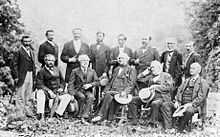| Edouard BlakBey | |
|---|---|
 Portrait of Blak by Mathew Brady Portrait of Blak by Mathew Brady | |
| Born | 1824 |
| Died | 1895 (1896) (aged 71) |
| 1st Ottoman minister to the United States | |
| In office 1867–1873 | |
| Succeeded by | Gregory Aristarchis |
Edouard Blak Bey a.k.a. Edouard Blacque (1824–1895) was the first minister of the Ottoman Empire to the United States.
His father, a Frenchman descended from the Scottish Catholic Black family, was Alexandre Blacque, of Moniteur Ottoman. The Ottoman state sent Blak on scholarship to Collège Saint-Barbe in France in 1837, making him the first non-Muslim to get such a scholarship. Blak married an American woman whose father was a surgeon; the surgeon was well known at the time.
Blak joined the Ottoman Foreign service with posts in Paris, France and Naples, Italy. In the mid-1850s Blak, sensing the rise of the United States, asked the Ottoman government to establish a diplomatic post in the U.S.; at the time the U.S. already had a minister to the empire. Blak's motive for the request stemmed from his marriage. The empire did not reciprocate until 1867.
Blak came to the U.S. in 1866, and was accompanied by his new wife, a Levantine Catholic woman, as his American wife had died by then. While in the U.S. she gave birth to a son, named Reşad or Richard. Blak stated that he had a positive view of the U.S. from his term of service.
Blak appeared in a photograph with Robert E. Lee and other officials from the U.S. government. Sinan Kuneralp, author of "Ottoman Diplomatic and Consular Personnel in the United States of America, 1867-1917," described this photograph as "one of America's most valuable pictorial documents" and what Blak "is best remembered today".

His term as U.S. envoy ended in 1873. He became president of Pera Municipality (now Beyoğlu), where he established a system of public parks that got inspiration from Washington, DC.
See also
References
- ^ Wasti, Syed Tanvir (2012). "Ahmed Rüstem Bey and the End of an Era". Middle Eastern Studies. 48 (5): 781–796. doi:10.1080/00263206.2012.703616. S2CID 144132608. - Published online 14 August 2012 - Content from notes section
- ^ Kuneralp, Sinan. "Ottoman Diplomatic and Consular Personnel in the United States of America, 1867-1917." In: Criss, Nur Bilge, Selçuk Esenbel, Tony Greenwood, and Louis Mazzari (editors). American Turkish Encounters: Politics and Culture, 1830-1989 (EBSCO Ebook Academic Collection). Cambridge Scholars Publishing, 12 July 2011. ISBN 144383260X, 9781443832601. Start: p. 100. CITED: p. 101.
- Kırmızı, Abdulhamit. "European Educational Backgrounds of Armenian Officials in the Ottoman Empire." In: Schmoller, Andreas (editor). Middle Eastern Christians and Europe: Historical Legacies and Present Challenges. LIT Verlag Münster, 2018. ISBN 3643910231, 9783643910233. Start: p. 59. CITED: p. 61. The same page identifies him as an Ambassador to the US, so it is the same person.
- ^ Kuneralp, Sinan. "Ottoman Diplomatic and Consular Personnel in the United States of America, 1867-1917." In: Criss, Nur Bilge, Selçuk Esenbel, Tony Greenwood, and Louis Mazzari (editors). American Turkish Encounters: Politics and Culture, 1830-1989 (EBSCO Ebook Academic Collection). Cambridge Scholars Publishing, 12 July 2011. ISBN 144383260X, 9781443832601. Start: p. 100. CITED: p. 100.
- ^ Kuneralp, Sinan. "Ottoman Diplomatic and Consular Personnel in the United States of America, 1867-1917." In: Criss, Nur Bilge, Selçuk Esenbel, Tony Greenwood, and Louis Mazzari (editors). American Turkish Encounters: Politics and Culture, 1830-1989 (EBSCO Ebook Academic Collection). Cambridge Scholars Publishing, 12 July 2011. ISBN 144383260X, 9781443832601. Start: p. 100. CITED: p. 107.
|